
USS Admiral W. S. Sims (AP-127) was a transport in the United States Navy. She was later renamed USNS General William O. Darby (T-AP-127). Later her name was struck and she was known simply by her hull number. In 1981, she was reclassified as IX-510.

USS General A. W. Greely (AP-141) was a General G. O. Squier-class transport ship named for U.S. Army general Adolphus Greely. She was transferred to the U.S. Army as USAT General A. W. Greeley in 1946. On 1 March 1950 she was transferred to the Military Sea Transportation Service (MSTS) as USNS General A. W. Greely (T-AP-141). She was later sold and converted to a container ship and operated under several names before being scrapped in 1986.
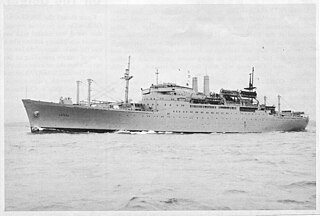
USNS Geiger (T-AP-197)/USTS Bay State IV was a transport ship in the United States Navy. She was named after General Roy Geiger, who, from July 1945 to November 1946, commanded Marine Force, Pacific Fleet.

USS General Stuart Heintzelman (AP-159) was a General G. O. Squier-class transport ship for the U.S. Navy in World War II. She was named in honor of U.S. Army general Stuart Heintzelman. She was transferred to the U.S. Army as USAT General Stuart Heintzelman in 1946. On 1 March 1950 she was transferred to the Military Sea Transportation Service (MSTS) as USNS General Stuart Heintzelman (T-AP-159). She was later sold for commercial operation before being scrapped in 1984.

USS General LeRoy Eltinge (AP-154) was a General G. O. Squier-class transport ship for the US Navy in World War II. She was named in honor of US Army general LeRoy Eltinge. She was transferred to the US Army as USAT General LeRoy Eltinge in 1946. On 20 July 1950 she was transferred to the Military Sea Transportation Service (MSTS) as USNS General LeRoy Eltinge (T-AP-154). She was later sold for commercial use and operated under the names SS Robert E. Lee and SS Robert Toombs, before being scrapped in 1980.
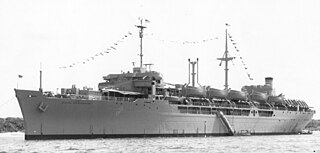
USS General R. M. Blatchford (AP-153) was a General G. O. Squier-class transport ship for the U.S. Navy in World War II. She was named in honor of U.S. Army general Richard M. Blatchford. She was transferred to the U.S. Army as USAT General R. M. Blatchford in 1946. On 1 March 1950 she was transferred to the Military Sea Transportation Service (MSTS) as USNS General R. M. Blatchford (T-AP-153). She was later sold for commercial operation under the names SS Stonewall Jackson and Alex Stephens, before being scrapped in 1980.

USS General W. M. Black (AP-135) was a General G. O. Squier-class transport ship for the U.S. Navy in World War II. The ship was crewed by the U.S. Coast Guard until decommissioning. She was named in honor of U.S. Army general William Murray Black. She was transferred to the U.S. Army as USAT General W. M. Black in 1946. On 1 March 1950 she was transferred to the Military Sea Transportation Service (MSTS) as USNS General W. M. Black (T-AP-135). She was later sold for commercial operation under the name SS Green Forest, before being scrapped in 1980.

USS General S. D. Sturgis (AP-137) was a General G. O. Squier-class transport ship for the U.S. Navy in World War II. She was named in honor of U.S. Army general Samuel Davis Sturgis. She was transferred to the U.S. Army as USAT General S. D. Sturgis in 1946. On 1 March 1950 she was transferred to the Military Sea Transportation Service (MSTS) as USNS General S. D. Sturgis (T-AP-137). She was later sold for commercial operation under the name SS Green Port, before being scrapped in 1980.

USS General M. B. Stewart (AP-140) was a General G. O. Squier-class transport ship for the U.S. Navy in World War II. She was named in honor of U.S. Army general Merch Bradt Stewart. She was transferred to the U.S. Army as USAT General M. B. Stewart in 1946. On 1 March 1950 she was transferred to the Military Sea Transportation Service (MSTS) as USNS General M. B. Stewart (T-AP-140). She was later sold for commercial operation under the name SS Albany, before being scrapped in July 1987.

USS General C. H. Muir (AP-142) was a General G. O. Squier-class transport ship for the U.S. Navy in World War II. The ship was crewed by the U.S. Coast Guard until decommissioning. She was named in honor of U.S. Army general Charles Henry Muir. She was transferred to the U.S. Army as USAT General C. H. Muir in 1946. On 1 March 1950 she was transferred to the Military Sea Transportation Service (MSTS) as USNS General C. H. Muir (T-AP-142). She was later sold for commercial operation under the names SS Chicago and SS San Juan, and was scrapped some time after 1985.

USS General H. F. Hodges (AP-144) was a General G. O. Squier-class transport ship for the U.S. Navy in World War II. The ship was crewed by the U.S. Coast Guard until decommissioning. She was named in honor of U.S. Army general Harry Foote Hodges. She was transferred to the U.S. Army as USAT General H. F. Hodges in 1946. On 1 March 1950 she was transferred to the Military Sea Transportation Service (MSTS) as USNS General H. F. Hodges (T-AP-144). She was later sold for commercial operation under the name SS James, before being scrapped in 1979.

USS General M. L. Hersey (AP-148) was a General G. O. Squier-class transport ship of the U.S. Navy in World War II. She was named in honor of U.S. Army general Mark Leslie Hersey. She was transferred to the U.S. Army as USAT General M. L. Hersey in 1946. On 1 March 1950 she was transferred to the Military Sea Transportation Service (MSTS) as USNS General M. L. Hersey (T-AP-148). She was later sold for commercial use, and operated under the names SS Pittsburgh and SS St. Louis.
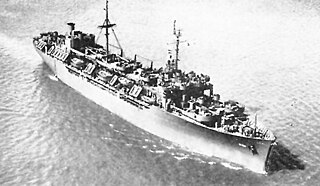
USS General W. C. Langfitt (AP-151) was a General G. O. Squier-class transport ship for the U.S. Navy in World War II. She was named in honor of U.S. Army general William Campbell Langfitt. She was transferred to the U.S. Army as USAT General W. C. Langfitt in 1946. On 1 March 1950 she was transferred to the Military Sea Transportation Service (MSTS) as USNS General W. C. Langfitt (T-AP-151). She was later sold for commercial operation under the name SS Transindiana, before ultimately being scrapped in 1983.

USS General W. A. Mann (AP-112) was a troop transport that served with the United States Navy in World War II, the Korean War and the Vietnam War.

USS General H. W. Butner (AP-113), named for Henry W. Butner, was a troopship that served with the United States Navy in World War II and the Korean War. She was redesignated T-AP-113 in October 1949.
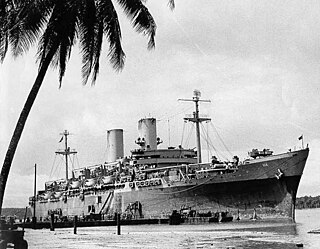
USS General William Mitchell (AP-114) was a troopship that served with the United States Navy in World War II, the Korean War and the Vietnam War.

USS General W. H. Gordon (AP-117) was a troop transport that served with the United States Navy in World War II. After the war, she was transferred to the US Army and served as USAT General W. H. Gordon. In the mid to late 1940’s she sailed in trans-Pacific American President Lines passenger service with sister ship SS General Meigs. With the outbreak of the Korean War, she was reacquired by the Navy as a civilian-manned Military Sea Transportation Service (MSTS) vessel, and redesignated USNS General W. H. Gordon (T-AP-117). She served again under the same designation in the Vietnam War.
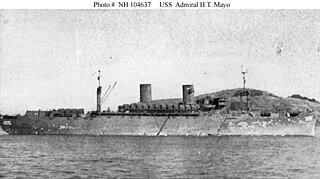
USS Admiral H. T. Mayo (AP-125) was a United States Navy Admiral W. S. Benson-class transport built by the Bethlehem-Alameda Shipyard, Inc., that entered service at the end of World War II. She partook in Operation Magic Carpet before being transferred to the U.S. Army for a short period, who renamed her USAT General Nelson M. Walker, before returning to the Navy. She was stricken from the Naval Vessel Register in January 1981 before being scrapped in 2005.
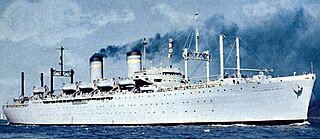
USS Admiral R. E. Coontz (AP-122) was an Admiral W. S. Benson-class transport built for the U.S. Navy during World War II. She was laid down under a Maritime Commission contract on 15 January 1943 at Alameda, California, by the Bethlehem Steel Corp., and launched on 22 April 1944. She was sponsored by Mrs. Edwin Kokko, daughter of Admiral Coontz, and commissioned on 21 November 1944, Capt. Montford R. Tawes, USNR, in command.

USS Admiral E. W. Eberle (AP-123) was laid down on 15 February 1943 under a Maritime Commission contract by the Bethlehem Shipbuilding Corporation, Alameda, California; launched on 14 June 1944; sponsored by Mrs. Earl Warren, the wife of the Governor of California who later became Chief Justice of the United States Supreme Court; and acquired by the Navy and commissioned on 24 January 1945, Capt. G. C. Carlstedt, USCG, in command.




















